| Label |
Name/Division Cargo IMP Code |
Description |
Comments and/or Examples |
| Class 1 Explosive | |||
 |
Explosive Division 1.1 REX |
Articles and ubstances having a mass explosion hazard |
These explosives are normally forbidden for carriage by air e.g. TNT,Dynamite or Torpedoes, etc. |
 |
Explosive REX |
Articles and substances having a projection hazard | |
 |
Explosive
|
Articles and substances having a fire hazard and either a minor blast or minor projection hazard or both | |
 |
Explosive REX |
Artcles and substances which present no significant hazard | |
 |
Explosive REX |
Very insensitive substances which have a mass explosion hazard | |
 |
Division 1.6 REX |
Extremely insensitive articles which do not have a mass explosion hazard | |
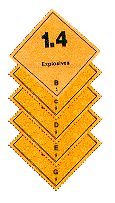 |
Explosives RXB |
Compatibility Group Assignment according to DGR Table 3.1.A |
Distress signals, Fuse igniters, etc. |
 |
Explosives RXS |
Articles and substances which present no significant hazard. Effect from accidental functioning is confined within the package |
Ammunition for hand weapons, for signals, Safety Fuses, certain types of Fireworks, etc. |
| Class 2 Gas | ▲Top | ||
 |
Flammable Gas RFG |
Any compressed gas which, when mixed with air in certain proportions, forms a flammable mixture. |
Butane, Hydrogen, Propane, Acetylene, Lighters |
 |
Non-Flammable non-toxic gas Division 2.2 RNG |
Any non-flammable, non- toxic compressed gas. |
Carbon dioxide, Neon, Fire Extinguisher, or low- temperature liquified gas such as liquified Nitrogen or Helium |
 |
Toxic Gas RPG |
Gases known to be toxic or corrosive to humans and known to pose a health risk |
Most toxic gases are forbidden for carriage by air; some are permitted, e.g. aerosols of low toxicity, tear gas devices. |
| Class 3 Flammable Liquid | ▲Top | ||
 |
Flammable Liquid RFL |
Any liquid having a closed- cup flash point of 60.5°C or below (DGR Appendix A). |
Certain Paints, Varnishes, Alcohols, some Adhesives, Acetone,Petrol, etc. |
| Class 4 Flammable solid | ▲Top | ||
 |
Flammable solid Division 4.1 RFS |
Any solid material, which is readily combustible, or may cause or contribute to fire through friction. |
Matches, sulphur, Celluloid, Note: Some are self- reactive. |
 |
Spontaneously RSC |
Such substances are liable to spontaneous heating or to heating up in contact with air and then liable to catch fire. |
White or Yellow phosphorus, Magnesium diamide |
 |
Dangerous When RFW |
Substances which, by interaction with water, are liable to become spontaneously flammable or give off flammable gases. |
Calcium carbide, sodium |
| Class 5 Oxidizer | ▲Top | ||
 |
Oxidizer ROX |
A substance that yields oxygen readily to stimulate the combustion of other material. |
Ammonium nitrate fertilizer, calcium chlorate, bleaches |
 |
Organic Peroxide ROP |
An organic material (liquid or solid) that can be ignited readily by external flame and then burns with an accelerating rate: some substances react dangerously with others. |
tert-Butyl hydroperoxide, listed in Appendix C of the DGR |
| Class 6 Toxic Substance | ▲Top | ||
 |
Toxic Substance RPB |
Liquids or solids which are dangerous if inhaled, swallowed or absorbed through the skin. |
Arsenic, Nicotine, Cyanide, Pesticides, Strychnine. Note: Some are totally forbidden,e.g. Bromoacetone |
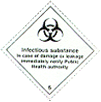 |
Infectious RIS |
Substances which are known or reasonably expected to contain pathogens and cause disease in humans or in animals. |
Virus, Bacteria, such as HIV (AIDS), Rabies, some diagnostic speci- mens and Medical and Clinical waste |
| Hazard Label |
Name Class Category Cargo IMP Code |
Maximum Surface Radioactive Level in μSv/h (mvem/h) Trasport Index (TI) |
Comments and/or Examples |
| Class 7 Radioactive | ▲Top | ||
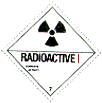 |
Radioactive RRW |
≤ 5 (0.5) TI = 0 |
Radionuclides or isotopes for medical or industrial purposes, such as Cobalt 60, Caesium 131 and lodine 132.
|
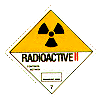 |
Radioactive RRY |
> 5 (0.5) ≤ 500 (50) TI = > 0 < 1 | |
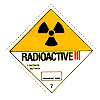 |
Radioactive RRY |
> 500 (50) ≤ 2000 (200) TI = > 1 ≤ 10 | |
| Hazard Label |
Name/Division Cargo IMP Code |
Description |
Comments and/or Examples |
| Class 8 Corrosive | ▲Top | ||
 |
Corrosive Material RCM |
A liquid or solid that causes full thickness destruction of intact skin tissue or has a severe corrosion rate on other materials. |
Battery acids, sulphuric and other acids, sodium hydroxide, potassium hydroxide, Mercury |
| Class 9 Miscellaneous | ▲Top | ||

|
Miscellaneous RMD |
Any substance which presents a danger during air transportation that is not covered by other classes. These include Aviation regulated solids or liquids, where materials may have an irritating, noxious or other properties which could cause extreme annoyance or discomfort to crew members preventing them from performing their duties. |
Asbestos, Garlic Oil, Life Rafts, Internal Combustion Engines, Vehicles |
|
Polymeric beads RSB |
Semi-processed polymeric articles, impregnated with a flammable gas or liquid as a blowing agent; may evolve small quantities of flammable gas. |
||
|
Carbon dioxide, ICE |
Carbon dioxide, solid/dry ice has a temperature of -79°C. On sublimation it produces a gas heavier than air which in an enclosed area and in larger quantities can lead to suffocation. |
||
 |
Magnetized MAG |
These materials have relatively high magnetic field strength. |
Magnetrons and non-shielded permanent magnets without keeper bars installed. |
上一篇:航空运单各联用途
下一篇:航空运输附加费之一缩写简析